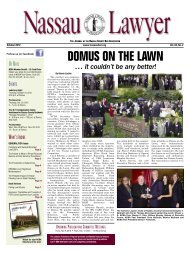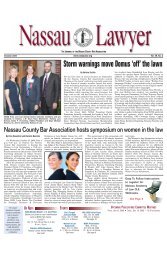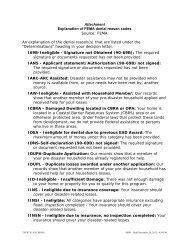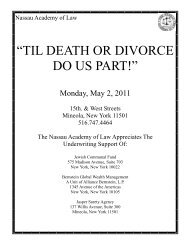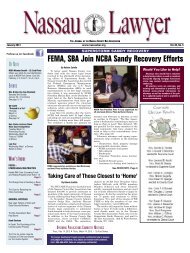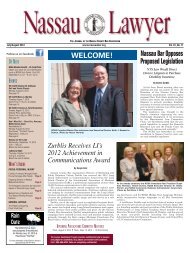394 B.R. 721 Page 14394 B.R. 721, 50 Bankr.Ct.Dec. 192(Cite as: 394 B.R. 721)during a period lasting nearly four years. The AmendedComplaint also includes the general allegations <strong>of</strong> insolvency(as well as the other financial tests), which are sufficientunder Federal Civil Rule 8. See Danning v. Lavine,572 F.2d 1386, 1388-89 (9th Cir.1978) (Kennedy, J.);Pereira v. Cogan, No. 00 Civ. 619(RWS), 2001 WL243537, at *8 (S.D.N.Y. Mar.8, 2001). Finally, theAmended Complaint alleges that debtors did not receivereasonably equivalent value or fair consideration from theFortgang Affiliates. The allegation is based on the contentionthat loan receivables generated by certain <strong>of</strong> the AffiliateTransfers, exceeding $50 million, could not havebeen repaid, and degraded over time. ( 25.) In addition,the JPMC Report, [FN15] discussed in more detail below,excluded all affiliate receivables in calculating MFS' bor-base. According to the plaintiff, this implied thatrowingthey "could not be valued at face." ( 43.)FN15. The JPMC Report is attached as ExhibitA to the Reply Declaration <strong>of</strong> Steven J. Mandelsbergin Further Support <strong>of</strong> Defendants' Motionsto Dismiss Complaint, dated March 4,2008, ("JPMC Report ") (ECF Doc. # 49).The factual allegations in the Amended Complaint providethe Pre-Petition Banks and SPM with clear notice <strong>of</strong>what the plaintiff intends to prove on the first prong; thedebtors reconveyed the Pre-Petition Bank loans and SPMgold to the Fortgang Affiliates in exchange for worthlessor near-worthless receivables at a time when they were orbecame insolvent or unable to continue their businesses. Icannot conclude that the constructive fraudulent transferclaims are implausible, as pleaded, or that the plaintiffshould be foreclosed from <strong>of</strong>fering evidence that thedebtors failed to receive reasonably equivalent value orfair consideration. Accordingly, the Amended Complaintsufficiently alleges that the debtors received transfersfrom the Pre-Petition Banks and SPM, or incurred obligationsbased on those transfers, and reconveyed the transferredproperty to the Fortgang Affiliates at a time whenthe debtors were or became insolvent (or met one <strong>of</strong> theother financial tests) for less than reasonably equivalentvalue or fair consideration.2. The Second Prong[16] The plaintiff must also plead that the defendants(other than Sovereign Bank) had actual or constructiveknowledge <strong>of</strong> the debtors' scheme to make the constructivefraudulent transfers to the Fortgang Affiliates. AlthoughRule 9(b) allows the pleader to allege knowledgegenerally, conclusory statements are insufficient. Instead,the complaint must allege some specific facts that supportan inference <strong>of</strong> knowledge. Devaney v. Chester, 813 F.2d566, 568-69 (2d Cir.1987); *737Elemary v. Holzmann,A.G., 533 F.Supp.2d 116, 132 (D.D.C.2008); seeSunbeam, 284 B.R. at 372-73. Thus, while conclusoryallegations <strong>of</strong> insolvency or inadequate consideration maysuffice for the purpose <strong>of</strong> alleging the elements <strong>of</strong> a constructivefraudulent transfer claim (under the first prong),they are not sufficient to support an allegation that thePre-Petition Banks and SPM knew that the transfers werefraudulent. Instead, the plaintiff must plead the minimalfacts necessary to present a plausible claim that the Pre-Banks and SPM knew or should have known <strong>of</strong>Petitionthe Fortgangs' scheme.According to the plaintiff, the defendants (other thanSovereign Bank) had knowledge as early as January 2003,<strong>of</strong> "the existence <strong>of</strong> the Fortgang Affiliates, <strong>of</strong> the factthat the Fortgang Affiliates were not owned by MFS, <strong>of</strong>MFS's practice <strong>of</strong> funding those Fortgang Affiliates, <strong>of</strong>the fact that a substantial portion, if not virtually all, <strong>of</strong>the funding the Pre-Petition Banks would advance to MFSin the future would be transferred to Fortgang Affiliatesand <strong>of</strong> MFS's deteriorating financial condition from January2001 to the Petition Date." ( 42; see also OppositionMemo at 42.) The defendants (other than Sovereign Bank)also "had knowledge that any consideration MFS wouldreceive from the Fortgang Affiliates would be <strong>of</strong> little orno value to MFS." ( 43.)The principal factual support for the allegations regardingknowledge comes from the JPMC Report. In 2002, JPMCcommissioned the report to assist it in deciding whether toextend an unsecured credit facility to MFS in the sum <strong>of</strong>$51,500,000. (JPMC Report at 1577.) [FN16] The JPMCReport indicated that MFS conducted an ongoing jewelrybusiness, at least prior to October 2002, which includedsignificant business transactions with the Fortgang Affiliates.MFS primarily purchased its inventory overseas,typically from affiliates, [FN17] (Id. at 1579, 1592), butsubstantial credits traveled in both directions. As <strong>of</strong> October31, 2002, MFS owed accounts payable in the sum <strong>of</strong>$130,383,947 to the affiliates, and the affiliates owedMFS accounts receivable <strong>of</strong> $67,971,893, i.e., MFS owedthe affiliates the net amount <strong>of</strong> $62,412,054. (Id. at 1669.)In addition, the affiliates owed MFS $50,059,335 on account<strong>of</strong> intercompany loans, and MFS owed its affiliates$ 18,868,370, also on account <strong>of</strong> intercompany loans. (Id.at 1672.)© 2009 Thomson Reuters. No Claim to Orig. US Gov. Works.
394 B.R. 721 Page 15394 B.R. 721, 50 Bankr.Ct.Dec. 192(Cite as: 394 B.R. 721)FN16. The citation to page numbers in the JPMCReport refers to the Bates-stamped page numbers.Each page is stamped with a consecutive,five digit number that begins with "0." The initial"0" has been omitted from the citation.FN17. There is a near complete overlap betweenthe MFS affiliates referred to in the JPMC Report,(see JPMC Report at 1644, 1669), and theFortgang Affiliates listed on Exhibit A to theAmended Complaint.As noted, the affiliate receivables were ignored for thepurpose <strong>of</strong> computing the borrowing base. The JPMCReport showed that MFS still had $159,320,457 in eligiblereceivables, $152 million in bank debt, and over$7,320,457 in excess availability. (Id. at 1628.) Furthermore,this did not take into account MFS' total inventory<strong>of</strong> $203,483,000. (Id.) In short, the JPMC Report revealedan entity with plenty <strong>of</strong> unencumbered liquid assets.Consequently, the JPMC Report did not provide theminimal factual basis to support a plausible argument thatthe Pre-Petition Banks and SPM knew or should haveknown <strong>of</strong> the Fortgangs' alleged scheme to make constructivefraudulent transfers to the Fortgang Affiliates.First, the Amended Complaint alleges, partly on informationand belief, that the Pre-Petition *738 Banks receivedthe report, ( 43), but does not allege that SPM ever sawit.[17] Second, it does not support the conclusory statementthat the Pre-Petition Banks knew that MFS did not "own"the Fortgang Affiliates. To the contrary, the JPMC Reportreferred to them as "affiliates," suggesting the oppositeconclusion. Furthermore, transfers to third parties, particularlyaffiliates, are supported by fair considerationwhen the debtor benefits indirectly. Indirect benefits mayinclude synergy, increased access to capital, safeguardinga source <strong>of</strong> supply and protecting customer relationships.Leibowitz v. Parkway Bank Trust Co. (In re ImageWorldwide, Ltd.), 139 F.3d 574, 578-79 (7th Cir.1998);Nirvana Rest., 337 B.R. at 502.The JPMC Report indicated, in this regard, that MFS andthe affiliates made intercompany transfers in furtherance<strong>of</strong> their respective businesses, and depended on each otherto conduct their respective businesses. MFS depended onthe Fortgang Affiliates to provide most <strong>of</strong> its inventory,and relied on their credit to obtain it--MFS owed far moreto the Fortgang Affiliates than they owed to MFS. If anything,the JPMC Report implied that MFS used the Pre-Petition Bank loans to fund legitimate business transactionswith the Fortgang Affiliates. Although the JPMCReport also showed net loans to affiliates aggregatingover $30 million, the purchase and sale transactions, andthe corresponding accounts payable and receivable,dwarfed the amount <strong>of</strong> the loans. Under the circumstances,knowledge that affiliated entities engaged in thesame business and bought and sold each other's productsundercuts an inference <strong>of</strong> knowledge, actual or constructive,that the transfers between them were part <strong>of</strong> afraudulent scheme.Third, the JPMC Report does not support the allegationthat the Pre-Petition Banks knew or should have knownthat MFS' financial condition was deteriorating, or moreto the point, that the transfers to the Fortgang Affiliatesrendered MFS insolvent or unable to continue in business.MFS had substantial liquid assets, in the form <strong>of</strong> receivablesand inventory, which exceeded its bank debt by asignificant margin. MFS continued to operate for anotherfour years before filing a chapter 11 petition. Most significantly,the Pre-Petition Banks continued to make unsecuredloans to MFS for approximately two years afterthey allegedly saw the JPMC Report. [FN18] Their lendingactivities were inconsistent with the actual or constructiveknowledge that the Fortgangs were siphoningMFS' assets and transferring them to the Fortgang Affili-for no consideration, and rendering the debtors insol-atesvent or unable to continue in business in the process.FN18. The Amended Complaint alleges that thePre-Petition Banks secured their loans in October2004. While this may support an inference thatthey perceived an increased risk <strong>of</strong> collection, itdoes not support an inference that they knew orshould have known that MFS was insolvent oron the verge <strong>of</strong> becoming insolvent--the Pre-Petition Banks continued to make loans. Furthermore,the Amended Complaint does not provideany facts relating to MFS' financial conditionin October 2004, or the Pre-Petition Banks'knowledge <strong>of</strong> that condition.Apparently sensing some skepticism on the reader's partthat the Pre-Petition Banks would knowingly making uncollectibleloans, the Amended Complaint <strong>of</strong>fered a variety<strong>of</strong> reasons why the Pre-Petition Banks made the loansanyway. According to 45, they did so out <strong>of</strong> a "desire tobe recognized as the premier lenders to the internationaljewelry and diamond industry," "*739 their belief that it© 2009 Thomson Reuters. No Claim to Orig. US Gov. Works.
- Page 1 and 2:
Nassau Academy of LawCLE Live Class
- Page 3 and 4:
McKinney's Debtor and Creditor Law
- Page 5 and 6:
McKinney's Debtor and Creditor Law
- Page 7 and 8:
McKinney's Debtor and Creditor Law
- Page 9 and 10:
McKinney's Debtor and Creditor Law
- Page 11 and 12:
McKinney's Debtor and Creditor Law
- Page 13 and 14:
McKinney's Debtor and Creditor Law
- Page 15 and 16:
McKinney's Debtor and Creditor Law
- Page 17 and 18:
McKinney's Debtor and Creditor Law
- Page 19 and 20:
BAKER & HOSTETLER LLP45 Rockefeller
- Page 21 and 22:
usiness of defendant Bernard L. Mad
- Page 23 and 24:
BACKGROUND, THE TRUSTEE, AND STANDI
- Page 25 and 26:
Madoff who received fraudulent tran
- Page 27 and 28:
ased on fictitious profits and for
- Page 29 and 30:
28. BLMIS funds were also used to p
- Page 31 and 32:
Madoff, and her niece, Shana Madoff
- Page 33 and 34: 42. Ruth Madoff was never an employ
- Page 35 and 36: FIRST CAUSE OF ACTIONTURNOVER AND A
- Page 37 and 38: 66. At the time of each of the Two-
- Page 39 and 40: Transfers; (b) directing that the S
- Page 41 and 42: EIGHTH CAUSE OF ACTIONUNDISCOVERED
- Page 43 and 44: TENTH CAUSE OF ACTIONDISALLOWANCE O
- Page 45 and 46: 111. Mrs. Madoff benefited from the
- Page 47 and 48: WHEREFORE, the Trustee respectfully
- Page 49 and 50: 2(c)(3): (a) preserving the Subsequ
- Page 51 and 52: 302 B.R. 760 Page 1302 B.R. 760(Cit
- Page 53 and 54: 302 B.R. 760 Page 3302 B.R. 760(Cit
- Page 55 and 56: 302 B.R. 760 Page 5302 B.R. 760(Cit
- Page 57 and 58: 302 B.R. 760 Page 7302 B.R. 760(Cit
- Page 59 and 60: 302 B.R. 760 Page 9302 B.R. 760(Cit
- Page 61 and 62: 302 B.R. 760 Page 11302 B.R. 760(Ci
- Page 63 and 64: 302 B.R. 760 Page 13302 B.R. 760(Ci
- Page 65 and 66: 302 B.R. 760 Page 15302 B.R. 760(Ci
- Page 67 and 68: 302 B.R. 760 Page 17302 B.R. 760(Ci
- Page 69 and 70: 302 B.R. 760 Page 19302 B.R. 760(Ci
- Page 71 and 72: 394 B.R. 721 Page 1394 B.R. 721, 50
- Page 73 and 74: 394 B.R. 721 Page 3394 B.R. 721, 50
- Page 75 and 76: 394 B.R. 721 Page 5394 B.R. 721, 50
- Page 77 and 78: 394 B.R. 721 Page 7394 B.R. 721, 50
- Page 79 and 80: 394 B.R. 721 Page 9394 B.R. 721, 50
- Page 81 and 82: 394 B.R. 721 Page 11394 B.R. 721, 5
- Page 83: 394 B.R. 721 Page 13394 B.R. 721, 5
- Page 87 and 88: 394 B.R. 721 Page 17394 B.R. 721, 5
- Page 89 and 90: 394 B.R. 721 Page 19394 B.R. 721, 5
- Page 91 and 92: 394 B.R. 721 Page 21394 B.R. 721, 5
- Page 93 and 94: 397 B.R. 642 Page 2397 B.R. 642(Cit
- Page 95 and 96: 397 B.R. 642 Page 4397 B.R. 642(Cit
- Page 97 and 98: 397 B.R. 642 Page 6397 B.R. 642(Cit
- Page 99 and 100: 397 B.R. 642 Page 8397 B.R. 642(Cit
- Page 101 and 102: 397 B.R. 642 Page 10397 B.R. 642(Ci
- Page 103 and 104: 397 B.R. 642 Page 12397 B.R. 642(Ci
- Page 105 and 106: 397 B.R. 642 Page 14397 B.R. 642(Ci
- Page 107 and 108: 443 F.3d 180 Page 2443 F.3d 180(Cit
- Page 109 and 110: 443 F.3d 180 Page 4443 F.3d 180(Cit
- Page 111 and 112: 443 F.3d 180 Page 6443 F.3d 180(Cit
- Page 113 and 114: 443 F.3d 180 Page 8443 F.3d 180(Cit
- Page 115 and 116: 443 F.3d 180 Page 10443 F.3d 180(Ci
- Page 117 and 118: 443 F.3d 180 Page 12443 F.3d 180(Ci
- Page 119 and 120: Page 2257 A.D.2d 526, 684 N.Y.S.2d
- Page 121 and 122: Page 4257 A.D.2d 526, 684 N.Y.S.2d
- Page 123 and 124: Page 6257 A.D.2d 526, 684 N.Y.S.2d
- Page 125 and 126: 770 N.Y.S.2d 421 Page 22 A.D.3d 780
- Page 127 and 128: Page 14 A.D.3d 495, 773 N.Y.S.2d 71
- Page 129: Page 34 A.D.3d 495, 773 N.Y.S.2d 71
- Page 132 and 133: 780 N.Y.S.2d 409 Page 29 A.D.3d 553
- Page 134 and 135:
Page 134 A.D.3d 231, 824 N.Y.S.2d 3
- Page 136 and 137:
Page 334 A.D.3d 231, 824 N.Y.S.2d 3
- Page 138 and 139:
Page 2991 F.2d 31(Cite as: 991 F.2d
- Page 140 and 141:
Page 4991 F.2d 31(Cite as: 991 F.2d
- Page 142 and 143:
Page 6991 F.2d 31(Cite as: 991 F.2d
- Page 144 and 145:
FRAUDULENT TRANFERENCESRonald M. Te
- Page 146 and 147:
Nursing home case_ Transfer of pers
- Page 148 and 149:
Sections 548 and 544 work in concer
- Page 150 and 151:
U.S. Supreme CourtBFP v. Resolution
- Page 152 and 153:
example, from net 15 to COD; or cha
- Page 154 and 155:
Bankruptcy Code Section§ 548. Frau
- Page 156:
Ron Terenzi is a founding partner a



